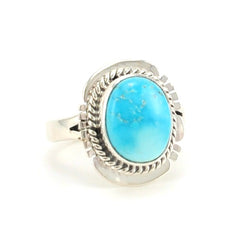
Turquoise Jewelry
Focus this week is on Zuni and Navajo jewelry handmade in the USA with American turquoise. These pieces are always fashionable and are also collectible heirloom pieces that will be treasured for generations. Navajo artists learned silversmithing from Mexican silversmiths in the 1850s through trade. In the 1890s, the Zuni traded livestock for instruction in working silver after they admired the silver Navajo jewelry they had seen. The two tribes trade but have distinct elements of jewelry design that are preserved by clan and family tradition.

The first Navajo silversmiths created buckles, buttons, rings, earrings, bracelets, crescent shape pendants called "najas" and much more. The Squash Blossom necklace is the most important and most identifiable form in Navajo and Southwestern Native American jewelry. The design consists of handmade round silver beads copied from Spanish buttons that is interspersed with "squash blossom," or flower-like elongated beads, and featured a "naja" pendant in the center, similar to an upside down horseshoe. Both Navajo and Zuni artists create this style of necklace.
Turquoise was not used in Native American jewelry until later in the 1880s even though the stone was mined over a thousand years ago by ancient Native American tribes. Turquoise is mined throughout America's southwest though many mines have been closed and depleted. Turquoise signifies success, it is the "fallen sky stone" hidden in Mother Earth, and is worn for good fortune, protection and good health.
Even though Zuni jewelry did not include silver until the 1890s, Zuni jewelry dates back to Ancestral Pueblo prehistory. Zuni lapidaries carved stone and shell fetishes using stone and antler tools and strung them with fiber cords. Zuni jewelers are credited for combining turquoise and silver. They became known for the intricate cluster work and small stone techniques like needlepoint and petit point.
See our whole Southwestern Collection at http://shopbejeweled.com/collections/southwestern-jewelry.
